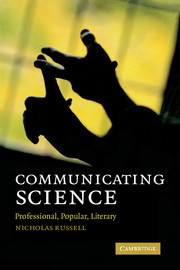Book contents
- Frontmatter
- Contents
- Introduction: What this book is about and why you might want to read it
- Prologue: Three orphans share a common paternity: professional science communication, popular journalism and literary fiction are not as separate as they seem
- Part I Professional science communication
- Part II Science for the public: what science do people need and how might they get it?
- Part III Popular science communication: the press and broadcasting
- 10 What every scientist should know about the mass media
- 11 What every scientist should know about journalists
- 12 The influence of new media
- 13 How the media represent science
- 14 How should science journalists behave?
- Part IV The origins of science in cultural context: five historic dramas
- Part V Science in literature
- Index
- References
14 - How should science journalists behave?
Published online by Cambridge University Press: 02 December 2010
- Frontmatter
- Contents
- Introduction: What this book is about and why you might want to read it
- Prologue: Three orphans share a common paternity: professional science communication, popular journalism and literary fiction are not as separate as they seem
- Part I Professional science communication
- Part II Science for the public: what science do people need and how might they get it?
- Part III Popular science communication: the press and broadcasting
- 10 What every scientist should know about the mass media
- 11 What every scientist should know about journalists
- 12 The influence of new media
- 13 How the media represent science
- 14 How should science journalists behave?
- Part IV The origins of science in cultural context: five historic dramas
- Part V Science in literature
- Index
- References
Summary
Gerald Wheeler was both an American university teacher and a television science presenter. His presenter experiences show clearly that successful science communication is subservient to media agendas and that popularization should not aim to be too ambitious. Almost by accident Wheeler was asked to do a series of Saturday science shows for children, which he called ‘sidewalk science’. He approached these shows as an opportunity to jazz up what he was already teaching to undergraduates but that approach didn't work. Running shows round principles like ‘forces’ was of no interest to anyone. He had been lulled into supposing that people were interested in that kind of thing from his captive undergraduate audiences. They wanted to be physicists or engineers and had to pass the exams. Schoolchildren at leisure had no such incentives.
He also learned that classroom science demonstrations and classroom pace were not effective on television. He had to have a ‘tease’ at the top of the programme and everything had to be much faster and less hedged with caveats than a lecture or class. While he got better at entertaining his juvenile audience, his colleagues criticized him for the ‘errors’ he was introducing. At first this worried him, until he realized that such ‘error’ is inevitable and did not matter for the purposes of his audience.
Later he acted as an advisor on another television show for young viewers and observed how scientists and media people talked in different languages and were focused on different issues. It took a long time to work out situations that were scientifically correct but also worked as television. […]
- Type
- Chapter
- Information
- Communicating ScienceProfessional, Popular, Literary, pp. 190 - 202Publisher: Cambridge University PressPrint publication year: 2009



